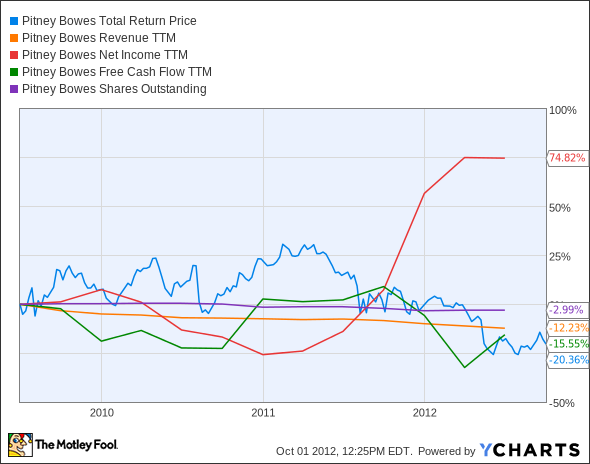Is Pitney Bowes Destined for Greatness?
Every investor can appreciate a stock that consistently beats the Street without getting ahead of its fundamentals and risking a meltdown. The best stocks offer sustainable market-beating gains, with improving financial metrics that support strong price growth. Let's take a look at what Pitney Bowes' (NYS: PBI) recent results tell us about its potential for future gains.
What the numbers tell you
The graphs you're about to see tell Pitney Bowes' story, and we'll be grading the quality of that story in several ways.
Growth is important on both top and bottom lines, and an improving profit margin is a great sign that a company's become more efficient over time. Since profits may not always reported at a steady rate, we'll also look at how much Pitney Bowes' free cash flow has grown in comparison to its net income.
A company that generates more earnings per share over time, regardless of the number of shares outstanding, is heading in the right direction. If Pitney Bowes' share price has kept pace with its earnings growth, that's another good sign that its stock can move higher.
Is Pitney Bowes managing its resources well? A company's return on equity should be improving, and its debt-to-equity ratio declining, if it's to earn our approval.
Healthy dividends are always welcome, so we'll make sure that Pitney Bowes' dividend payouts are increasing, but at a level that can be sustained by its free cash flow.
By the numbers
Now, let's take a look at Pitney Bowes' key statistics:
PBI Total Return Price data by YCharts.
Criteria | 3-Year* Change | Grade |
|---|---|---|
Revenue growth > 30% | (12.2%) | Fail |
Improving profit margin | (6.0%) | Fail |
Free cash flow growth > net income growth | (15.5%) vs. 74.8% | Fail |
Improving EPS | 80.5% | Pass |
Stock growth (+ 15%) < EPS growth | (20.4%) vs. 80.5% | Pass |
Source: YCharts. *Period begins at end of Q2 2009.
PBI Dividend data by YCharts.
Criteria | 3-Year* Change | Grade |
|---|---|---|
Improving return on equity | NM** | Fail |
Declining debt to equity | (20%) | Pass |
Dividend growth > 25% | 4.2% | Fail |
Free cash flow payout ratio < 50% | 46.4% | Pass |
Source: YCharts. *Period begins at end of Q2 2009. **NM = not meaningful; negative equity reported during current period.
How we got here and where we're going
Pitney Bowes has managed to improve its earnings thanks to some one-off accounting benefits, but most of its other metrics haven't followed suit, and so the company earns a mediocre four out of nine possible passing grades. The company currently reports negative shareholder equity, making it impossible to award it a passing grade on its debt-to-equity ratios. Debt levels are high, but are at least in decline.
The Fool's analysts have pointed out Pitney Bowes' weaknesses multiple times this year. After one recent 52-week low, Sean Williams noted that the company hasn't managed to fend off Stamps.com (NAS: STMP) or Newell Rubbermaid in the online-postage space, despite its once-dominant position as a business-focused postage provider. Keith Speights sounded a death knell for Pitney Bowes' monster yield, pointing out its reliance on a business in secular decline -- namely, mail lacking that newfangled e- prefix. Fool analyst Rex Moore was surprised when this high-yielder showed up on his stock screen, since its heavy debt makes the dividend's long-term stability a bit shaky.
Does that make Pitney Bowes a dividend dominator with one foot in the grave? It's trying its best to stay out of the graveyard. Since its post-recession collapse, the company has partnered with three of the biggest current threats to the Post Office's business model -- FedEx (NYS: FDX) , UPS (NYS: UPS) , and Facebook (NAS: FB) . FedEx and UPS handle the lion's share of an ever-growing volume of Internet-based shipping, but the partnership hasn't paid off yet. The deals were made in 2010, and both revenue and free cash flow have fallen since then.
Facebook's inked a deal to use Pitney Bowes' geocoding software, opening up a lucrative market of nearly a billion users. However, Pitney Bowes' inability to capitalize on the comparatively simple technology of online stamps makes me uncertain that the company can make this partnership work to its full advantage.
Putting the pieces together
Today, Pitney Bowes has few of the qualities that make up a great stock, but no stock is truly perfect. These numbers are likely to change over time, so it's important to keep track of Pitney Bowes' progress. If Pitney Bowes' dividend is in danger, you should be looking for safer payouts. The Fool's got three top-notch dividend stocks for you. These established market leaders don't have to worry about the Internet undercutting their business model -- they've even used it to become better companies. You can find out more in our free report: "The 3 Dow Stocks Dividend Investors Need."
The article Is Pitney Bowes Destined for Greatness? originally appeared on Fool.com.
Fool contributor Alex Planes holds no financial position in any company mentioned here. Add him on Google+ or follow him on Twitter @TMFBiggles for more news and insights.The Motley Fool owns shares of Facebook. Motley Fool newsletter services have recommended buying shares of United Parcel Service, Facebook, and FedEx. The Motley Fool has a disclosure policy. We Fools may not all hold the same opinions, but we all believe that considering a diverse range of insights makes us better investors. Try any of our Foolish newsletter services free for 30 days.
Copyright © 1995 - 2012 The Motley Fool, LLC. All rights reserved. The Motley Fool has a disclosure policy.



